| Srl | Item |
| 1 |
ID:
157040
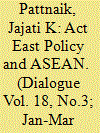

|
|
|
| 2 |
ID:
135463
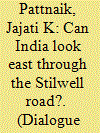

|
|
|
|
|
| Summary/Abstract |
Look East Policy in the contemporary world order intended to secure India’s foreign policy objectives with its Eastern neighbours based on geographical contiguity and civilisational ethos. As a precursor,
disintegration of the Soviet Union brought a tremendous transformation in the global geo-strategic environment entailing innovative ideas in the conduct of bilateral and multilateral relations. As a fallout, globalization was used as a tool for the diffusion of knowledge and technology stretching de-territorialized economic order. India mooted structural reforms in the nineties to deal with the emerging trends and focused on robust economic diplomacy to bring more foreign direct investment, promote Indian investment abroad as well as safeguard its economic and commercial interests in regional and multilateral trading agreements.1 As a corollary, regional and sub-regional arrangements flourished through cross-border trade and connectivity. The State-centric borders which were earlier treated as barriers for cross-border development became significant for cross-border ties signifying subregional
cooperation. Subsequently, India’s North Eastern region was incorporated in India’s Look East Policy to get rid of the hazards of geographical location and the strategy was devised to build up the economic links and connectivity with Myanmar and other South East Asian nations to bring in cross-border cooperation and development.2
|
|
|
|
|
|
|
|
|
|
|
|
|
|
|
|
| 3 |
ID:
147980
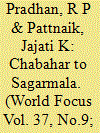

|
|
|
|
|
| Summary/Abstract |
India’s maritime space both externally and internally is under serious churning today. Caught between maritime forces and strategies building around South China Sea to Indo-Pacific region and the corresponding American ‘Asia Pivot’, India is riding maritime high table diplomacy in the neighbourhood sea lanes to protect and safeguard her strategic maritime assets and interests. Chabahar is one such India’s strategic naval diplomacy in the Persian Gulf. While the national and international media is agog with this maritime volatility and the corresponding stake holder countries moves and counter moves, India’s silent but strategic internal maritime space redrawing through ‘Sagarmala Project’ - India’s internal maritime connect grand strategy is not only a vision but a silent connectivity revolution in India’s coastal corridor towards an efficient maritime economy and efficiency.
|
|
|
|
|
|
|
|
|
|
|
|
|
|
|
|
| 4 |
ID:
159666
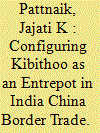

|
|
|
| 5 |
ID:
192938
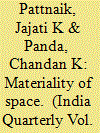

|
|
|
|
|
| Summary/Abstract |
The materiality of space refers to the material constituents determining the space. The spatial imagination of the borderland, characterised by critical spatiality, is materially constituted. The fact of being materially constituted means to be infrastructurally configured. The infrastructures here include hydro projects, highways, railroads, bridges, tunnels, airports, digital connectivity and other defence-related installations. These projects combine a two-pronged approach: security and development. The security challenges that the border space embodies compel the state to adopt an approach of competitive infrastructure building. The nature of this competition is determined by the competing other’s approach towards the border space. Arunachal Pradesh is a very critical border state that shares its crucial border space of 1,080 km with China, 160 km with Bhutan and 440 km with Myanmar. China’s increasing geopolitical clout in the region intensifies its spatial and material prominence. India under its Act East Policy (AEP) formulation in 2014 has taken up a very determined approach to accelerating infrastructure growth in the northeast and more particularly in Arunachal Pradesh for its border spatiality. Therefore, the border space loses its inferential, conjectural and abstract character and becomes materially determined. This imperative for materiality embodies, on the one hand, development, modernity, capitalist social space and mainstreaming of the neglected and, on the other hand, protectionism and upgradation of security architecture along critical geography known as the border space. Therefore, this study examines the development of materiality, meaning infrastructure, in a complex border space like Arunachal Pradesh. It decodes the economic logic of the systematic development of border space by the Indian nation-state from the point of view of the growth of the region and security urgency. It uses Henri Lefebvre’s theoretical formulations of spatiality to understand the convoluted category of border space and the introduction of material forces to achieve security and developmental objectives.
|
|
|
|
|
|
|
|
|
|
|
|
|
|
|
|
| 6 |
ID:
100859
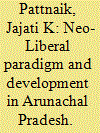

|
|
|
| 7 |
ID:
074287
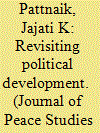

|
|
|